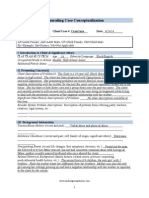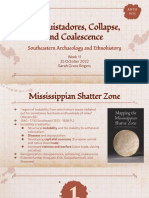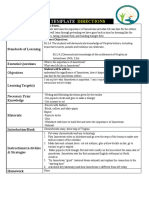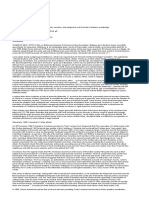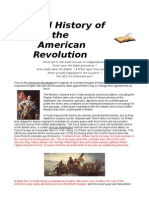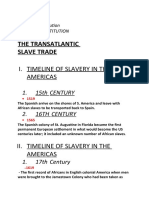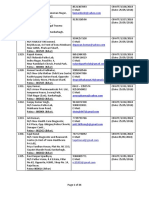Tobacco and Labor
Tobacco and Labor
Uploaded by
zwbennett4Copyright:
Available Formats
Tobacco and Labor
Tobacco and Labor
Uploaded by
zwbennett4Original Description:
Copyright
Available Formats
Share this document
Did you find this document useful?
Is this content inappropriate?
Copyright:
Available Formats
Tobacco and Labor
Tobacco and Labor
Uploaded by
zwbennett4Copyright:
Available Formats
Tobacco and Labor
Growing tobacco in Virginia was profitable for planters, but it required a large amount of land and a considerable labor force. The tobacco growing process
was a year-round occupation. First, land was cleared for fields. Seeds were started in January. Harvesting, curing and packing of the leaves occurred in late summer
and fall. With a small population in Virginia, planters sought workers from England, often paying their passage to the colony.
The system of indentured servitude was the answer to the dilemma faced by the Virginia Company and private landowners. It grew out of the two English
systems of service. One was apprenticeship, in which a person served a period of time to a master in exchange for food, clothing, housing and learning a skill or trade.
The other, service in husbandry, was a one-year period of agricultural or domestic service. The two were combined into the indenture system to supply labor for the
new colony. The period of service, usually four to seven years, was longer than service in husbandry in England because of the cost of transportation to Virginia.
In 1607 it seems that everyone, including gentlemen, came as a servant to the Virginia
Company, since there was no private ownership of land or supplies. After 1609, a seven-year
term was placed on service in exchange for a share in the Company profits and some land.
Seven years later, in 1616, there were no profits to pay investors. All the Company could give
was land, so for every share of stock, a shareholder got 100 acres of land. Those who had
invested their labor were promised land too. These former servants of the Company in theory
became landowners. When land grants began, servants came to Virginia to serve not only the
Virginia Company, but could be servants of private planters. In 1619 the General Assembly
clarified the indenture system, stipulating that indentures had to be recorded to enforce the
contract and to prevent masters from extending the period of servitude to which the parties had
agreed. One colonist wrote that year, All our riches for the present doe consiste in Tobacco
and our principall wealth . . . consisteth in servants.
An indentured servant signed a contract agreeing to work for a fixed periodusually four
to seven yearsin return for meals, clothes, shelter and their passage to the colony. At the
end of their term, the master was required to give the workers freedom dues, usually three
barrels of corn and a suit of clothes. After 1616, most freed servants did not receive land and
had to work for someone else, or as a tenant farmer, to acquire enough money to buy land.
They progressed through a series of steps from servant to tenant/renter, to landowner.
In 1622, John Upton came to Virginia as an indentured servant bound to Abraham
Peirsey, the cape merchant or person in charge of procuring supplies for the colony. Upton is
an example of a servant who was successful. He worked for Peirsey for three years on Peirseys
plantation, Flowerdew Hundred, until 1625, when he managed to buy his freedom, paying
Peirsey for the eight months remaining on his contract. In 1626 Upton rented a small farm on
Jamestown Island, agreeing to pay the owner partly in tobacco and partly in improvements to
the property. With a partner, Upton also became a part-time peddler or trader, buying items
from larger Jamestown merchants for resale to other colonists.
Upton prospered in his enterprises. By 1633 he was financially able to acquire a plantation of his own in Isle of Wight County, across the James River from
Jamestown. He continued to acquire land there and by 1637, he owned 2500 acres. Upton became one of Isle of Wights most prominent citizens, serving as a justice
of the peace, captain of the militia, and as a burgess in the General Assembly. He died in 1652, leaving a widow, Margaret, and a son, John Upton II.
At least half of the European immigrants who came to Virginia between 1620 and 1680 arrived as indentured servants. But the high death rate of new European immigrants kept labor in short supply. As the century progressed, fewer Europeans wanted to come to Virginia, and as the number of European servants could
not meet the demand for laborers, planters began to import Africans to work in their tobacco fields. Opportunities for white workers who had formerly been servants
then were reduced. The best land had already been taken. Poor free men were forced to move to Virginias western frontier, just beyond the fall line, where they
clashed with Indian groups who had been forced off of their lands too. This growing class of poor, landless free men now was deprived of the right to vote, or hold
government office. Social unrest led to Bacons Rebellion of 1676.
OTHER SOURCES
Billings, Warren. The Law of Servants and Slaves in Seventeenth-Century Virginia, in Virginia Magazine of History and Biography 99 ( January 1991): 45-53.
Billings, Warren, ed. The Old Dominion in the Seventeenth Century. Chapel Hill: University of North Carolina Press, 1975.
Galenson, David. White Servitude in Colonial America: An Economic Analysis. Cambridge: Cambridge University Press, 1981.
Horn, James. Adapting to a New World: English Society in the Seventeenth-Century Chesapeake. Chapel Hill: University of North Carolina Press, 1994.
Smith, Abbot Emerson. Colonists in Bondage: White Servitude and Convict Labor in America, 1607-1776. Chapel Hill: University of North Carolina Press, 1947.
Historical background materials made possible by Archibald Mathews Marks.
Jamestown-Yorktown Foundation
P.O. Box 1607, Williamsburg, VA 23187
You might also like
- One Pager by Period Review PacketDocument11 pagesOne Pager by Period Review PacketJul TolNo ratings yet
- Counseling Case Conceptualization Andrews FinalDocument11 pagesCounseling Case Conceptualization Andrews Finalapi-269876030100% (2)
- America A Narrative History Volume 1 Brief ElevenDocument1 pageAmerica A Narrative History Volume 1 Brief ElevenEmily BrieskeNo ratings yet
- Magna Carta WorksheetDocument3 pagesMagna Carta WorksheetBrett Flora0% (1)
- Life at JamestownDocument15 pagesLife at Jamestownzwbennett4No ratings yet
- Conquistadores Collapse and Coalescence RogersDocument63 pagesConquistadores Collapse and Coalescence Rogersapi-621525562No ratings yet
- FS Episode 8Document18 pagesFS Episode 8Abegail Linaga93% (104)
- EnlightconsguidednotesDocument4 pagesEnlightconsguidednotesapi-296241707No ratings yet
- Five Hundred Years in the New World, Vol. 1: WHARTON/WHORTON & Allied Families of North Carolina & Beyond, 1684-2021From EverandFive Hundred Years in the New World, Vol. 1: WHARTON/WHORTON & Allied Families of North Carolina & Beyond, 1684-2021No ratings yet
- Thirteen Colonies and English Empire Amsco ch2Document16 pagesThirteen Colonies and English Empire Amsco ch2ftacct5No ratings yet
- Create A Colony 2 pdf-2Document7 pagesCreate A Colony 2 pdf-2api-295144385No ratings yet
- Kaltwasser - Lesson Plan, LiberiaDocument3 pagesKaltwasser - Lesson Plan, LiberiaMr KaltwasserNo ratings yet
- The PuritansDocument15 pagesThe Puritansapi-269480354No ratings yet
- Aztec PresentationDocument16 pagesAztec Presentationapi-313135519No ratings yet
- Period 1.0 - America Before Columbus and Motivations For ExplorationDocument82 pagesPeriod 1.0 - America Before Columbus and Motivations For ExplorationWilliam NorthernNo ratings yet
- 01 Differences Between The North and The SouthDocument25 pages01 Differences Between The North and The SouthNina NovaNo ratings yet
- Colonial America OutlineDocument2 pagesColonial America Outlineapi-293174357No ratings yet
- Lesson Plan Template: DirectionsDocument3 pagesLesson Plan Template: Directionsapi-612420884No ratings yet
- America: North America, Central America, South AmericaDocument25 pagesAmerica: North America, Central America, South AmericaRizwan Nadeem100% (1)
- The Middle Ages: 1.1 Political DevelopmentsDocument26 pagesThe Middle Ages: 1.1 Political DevelopmentsJaime RuNo ratings yet
- The Canadian IndianDocument348 pagesThe Canadian IndianJan Pran100% (1)
- Acts and Biritish and Colonial Reactions ChartDocument1 pageActs and Biritish and Colonial Reactions ChartLauravgriggs100% (2)
- Exploration of America 1492-1600 Native American European ExploresDocument9 pagesExploration of America 1492-1600 Native American European ExploresДмитрий Портной100% (1)
- Colonization of America in DetailDocument14 pagesColonization of America in DetailPravinNo ratings yet
- River Valley Civilizations Day 3 1Document23 pagesRiver Valley Civilizations Day 3 1api-294843376No ratings yet
- The Colonization of AmericaDocument6 pagesThe Colonization of AmericaLoretta Lynn AltmayerNo ratings yet
- State Name Origin: AlabamaDocument2 pagesState Name Origin: AlabamaSham ShamNo ratings yet
- 1450-1750 PacketDocument6 pages1450-1750 Packetapi-259253396100% (1)
- Title - "The Race Leapt at Sauteurs" - Genocide, Narrative, and Indigenous Exile From The Caribbean Archipelago - The - Race - Leapt - at - Sauteurs...Document16 pagesTitle - "The Race Leapt at Sauteurs" - Genocide, Narrative, and Indigenous Exile From The Caribbean Archipelago - The - Race - Leapt - at - Sauteurs...Dionisio MesyeNo ratings yet
- Black People's of America-From Slavery To EqualityDocument16 pagesBlack People's of America-From Slavery To EqualityRaabhya AggarwalNo ratings yet
- The Barbary Captivity Narrative in American CultureDocument31 pagesThe Barbary Captivity Narrative in American CultureMohamed H RajmohamedNo ratings yet
- Document A: Reconcentration Camps: US Imperialism/ Spanish American WarDocument3 pagesDocument A: Reconcentration Camps: US Imperialism/ Spanish American Warpito100% (1)
- SlaveryDocument4 pagesSlaveryValeria GandraburNo ratings yet
- Alabama Affixes and Important WordsDocument28 pagesAlabama Affixes and Important Wordsalibamu montlerNo ratings yet
- "Ancient Inca Civilization" Category Description 1. Political SystemDocument8 pages"Ancient Inca Civilization" Category Description 1. Political SystemshaiNo ratings yet
- They Crucified Him Not, They Killed Him Not, With CertainDocument18 pagesThey Crucified Him Not, They Killed Him Not, With Certainagama_lNo ratings yet
- Spanish EmpireDocument67 pagesSpanish EmpirePaul CerneaNo ratings yet
- Exploration and Colonization of AmericaDocument26 pagesExploration and Colonization of AmericaUsra RasoolNo ratings yet
- 2 Southern Ne Middle ColoniesDocument53 pages2 Southern Ne Middle Coloniesapi-294843376100% (1)
- Jefferson's Draft - Declaration of Independence 1775Document7 pagesJefferson's Draft - Declaration of Independence 1775Giordano BrunoNo ratings yet
- Free at LastDocument72 pagesFree at Lastkhebert23No ratings yet
- Conquest of The Americas (Eakin-2002)Document81 pagesConquest of The Americas (Eakin-2002)GregNo ratings yet
- 8thsyllabus17 18Document2 pages8thsyllabus17 18api-291800932No ratings yet
- The Impact of Westward ExpansionDocument4 pagesThe Impact of Westward Expansionapi-445112426No ratings yet
- Bradford of Plymouth PlantationDocument12 pagesBradford of Plymouth PlantationJay’s SensationNo ratings yet
- Boston Tea PartyDocument3 pagesBoston Tea PartyCristal FlorianCordobaNo ratings yet
- Buried History of The American RevolutionDocument9 pagesBuried History of The American RevolutionwinmortalisNo ratings yet
- Early Colonial America: Lecture Slides and Concept QuestionsDocument45 pagesEarly Colonial America: Lecture Slides and Concept QuestionsAneesh IyerNo ratings yet
- Chaucer To ShakespeareDocument17 pagesChaucer To ShakespeareAbinaya RNo ratings yet
- Unit 2. British History TimelineDocument2 pagesUnit 2. British History Timeline21Nguyễn Đặng Hoàng My12A6NTTNo ratings yet
- 4.1 The Stirrings of RebellionDocument7 pages4.1 The Stirrings of RebellionPatrick ThorntonNo ratings yet
- 8 The Civil War Chapter 11Document96 pages8 The Civil War Chapter 11Joshua HatchNo ratings yet
- Rogers Joela - Bookcollection1848 1977Document15 pagesRogers Joela - Bookcollection1848 1977Damean Samuel100% (1)
- Ivan The Terrible & Peter The Great WebquestDocument3 pagesIvan The Terrible & Peter The Great WebquestNellie Noriega SantosNo ratings yet
- The AmericasDocument23 pagesThe AmericasRogerNo ratings yet
- Native American Disease and EpidemicsDocument19 pagesNative American Disease and EpidemicsTablet TabletNo ratings yet
- #Standingrocksyllabus: ContentsDocument41 pages#Standingrocksyllabus: ContentsAri El VoyagerNo ratings yet
- The Transatlantic Slave Trade: I. Timeline of Slavery in The AmericasDocument18 pagesThe Transatlantic Slave Trade: I. Timeline of Slavery in The AmericasDiliana LudivineNo ratings yet
- Indigenious Tribe, Indentured Servitute and SlaveryDocument4 pagesIndigenious Tribe, Indentured Servitute and SlaveryRishabh Kumar Singh SisodiaNo ratings yet
- Lecture 2 UpdatedDocument10 pagesLecture 2 UpdatedSanaAsifNo ratings yet
- Indraprastha College For WomenDocument9 pagesIndraprastha College For WomenMiss SwetlanaNo ratings yet
- Voc Guided Notes DiscussDocument1 pageVoc Guided Notes Discusszwbennett4No ratings yet
- Packing For JamestownDocument1 pagePacking For Jamestownzwbennett4No ratings yet
- Group Constitution DocsDocument6 pagesGroup Constitution Docszwbennett4No ratings yet
- Flow Chart AssignmentDocument7 pagesFlow Chart Assignmentzwbennett4No ratings yet
- Why Is Art Important? The Importance of Art in Everyone's LifeDocument2 pagesWhy Is Art Important? The Importance of Art in Everyone's LifeJhuma. Rinita MetaliksNo ratings yet
- Thermodynamic SystemDocument12 pagesThermodynamic SystemLORRAINE ATIENZANo ratings yet
- 2020-2021 Loeb Fellowship at Harvard Graduate School of DesignDocument3 pages2020-2021 Loeb Fellowship at Harvard Graduate School of DesignAyanna ReedNo ratings yet
- ClutchDocument9 pagesClutchAndryanNo ratings yet
- Lesson 4 Manicure and PedicureDocument22 pagesLesson 4 Manicure and PedicureMARY JOY VILLARUEL100% (3)
- Introduction To: PhytochemistryDocument39 pagesIntroduction To: PhytochemistryBem LimNo ratings yet
- Richmond The Shard Passive Voice PracticeDocument3 pagesRichmond The Shard Passive Voice PracticeAle PonceNo ratings yet
- CBCP Monitor Vol. 20 No. 17Document20 pagesCBCP Monitor Vol. 20 No. 17Areopagus Communications, Inc.100% (1)
- Department of Education Schools Division of Camarines SurDocument5 pagesDepartment of Education Schools Division of Camarines SurDayAnne Dela Vega PasibeNo ratings yet
- Deposito Diessel-Newberry - Data Sheet - Drawing - Single Fuel Tank PDFDocument4 pagesDeposito Diessel-Newberry - Data Sheet - Drawing - Single Fuel Tank PDFRolan PonceNo ratings yet
- Inventory MGT UltraTech Cement ST Joseph's 2024Document102 pagesInventory MGT UltraTech Cement ST Joseph's 2024ahmedaljeelaniNo ratings yet
- Physical Education and Health (H.O.P.E. 4) : Quarter 3 - Module 1Document24 pagesPhysical Education and Health (H.O.P.E. 4) : Quarter 3 - Module 1Vanessa SorianoNo ratings yet
- Foaming Cleanser: For Normal To Oily SkinDocument1 pageFoaming Cleanser: For Normal To Oily SkinmogoscristinaNo ratings yet
- Homework 1Document3 pagesHomework 1Yeily Guzman CastroNo ratings yet
- Organizational Culture DiagramDocument3 pagesOrganizational Culture Diagramfahad muhammadNo ratings yet
- Lo Shu Grid Numerology Calculator - Chinese Magic SquareDocument7 pagesLo Shu Grid Numerology Calculator - Chinese Magic SquarenightclownNo ratings yet
- The Business As Usual Behind The Slaughter - Lars SchallDocument17 pagesThe Business As Usual Behind The Slaughter - Lars SchallAlonso Muñoz PérezNo ratings yet
- From Saviour To Colonial Perpetrator Manipulating Player Empathy in Silent Hill 2 and Silent Hill OriginsDocument17 pagesFrom Saviour To Colonial Perpetrator Manipulating Player Empathy in Silent Hill 2 and Silent Hill OriginstiannixukellyNo ratings yet
- Baxco PharmaceuticalDocument8 pagesBaxco PharmaceuticalgrahamdaniellavonNo ratings yet
- Insects and Arachnids Part 12Document154 pagesInsects and Arachnids Part 12Andrei MoruziNo ratings yet
- B4 109 2014Document10 pagesB4 109 2014Yogesh OjhaNo ratings yet
- Span Drive Install ManualDocument19 pagesSpan Drive Install ManualChanpory RithNo ratings yet
- JRIZAL030 ConceptPaperFinalDocument2 pagesJRIZAL030 ConceptPaperFinalRoselle Balalitan PortudoNo ratings yet
- Buting Senior High School Media and Information Literacy Unit TestDocument2 pagesButing Senior High School Media and Information Literacy Unit TestGina BundaNo ratings yet
- Dokument - Pub CBWTF Registration 1326 1711 Flipbook PDFDocument34 pagesDokument - Pub CBWTF Registration 1326 1711 Flipbook PDFKriti KumariNo ratings yet
- SMK Green Road Term 2 Trial Exam 2019 MSDocument4 pagesSMK Green Road Term 2 Trial Exam 2019 MSvoon sjNo ratings yet
- 1-Stereotype 2-Violence 3 - Feminism 4-Self-Confidence 5 - Emancipation 6-Polygamy 7 - Gender 8 - International Women's DayDocument10 pages1-Stereotype 2-Violence 3 - Feminism 4-Self-Confidence 5 - Emancipation 6-Polygamy 7 - Gender 8 - International Women's DaySimo JinyøurNo ratings yet
- Department of Education: Republic of The PhilippinesDocument4 pagesDepartment of Education: Republic of The PhilippinesRowenick100% (6)

